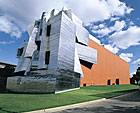|
|
|||||||||
|
FREDERICK R. WEISMAN
ART MUSEUM AT THE UNIVERSITY OF MINNESOTA Minneapolis 1990–93 Gehry's well-known engagement with the visual arts began with his exhibition designs for the Los Angeles County Museum of Art in the mid-1960s. He reconfigured gallery spaces to appropriately reflect their contents, whether as an austere Eastern setting for Art Treasures of Japan in 1965 or as an edgy motorcycle den featuring the retrospective Billy Al Bengston in 1968. In 1990, Gehry received his first commission for a public art museum. The Weisman's 11,000 square feet of gallery space are located on the third floor of a four-story rectilinear building. The galleries are relatively understated, though they are radically different from the anonymous boxes typical of museum architecture. Austere white walls are topped with geometric details of partially revealed trusses, and ceilings are punctuated by curvilinear slices, revealing skylights that permit natural light to bathe the interior. These striking elements complement the Modern and contemporary art housed inside. The exterior shapes expand upon the sculptural spaces within, announcing the museum's contemporary artistic program to passersby on the nearby Washington Avenue Bridge, and vermilion colored brick echoes the older brick buildings of the campus on which the museum is located. On the west facade, which overlooks the banks of the Mississippi River, stainless-steel panels converge in angles that ripple across the surface, mimicking the movement of the water below; the reflective surface transforms the museum into a gleaming landmark when viewed from across the river on a sunny day. |
||||||||
